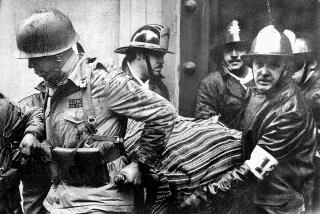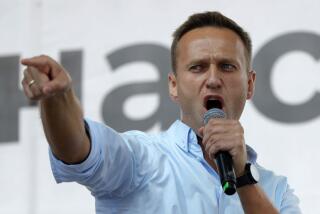‘Seven Days’ Recounts Soviet Coup : The co-author, Associated Press reporter Ann Imse, returned to her Garden Grove home after covering from Moscow one of the 20th Century’s most significant events.
- Share via
GARDEN GROVE — Associated Press reporter Ann Imse was still asleep in her Moscow apartment when the call came from the AP in New York that the Soviet news agency Tass was reporting that Soviet Vice President Gennady Yanayev had taken over the duties of president due to Mikhail Gorbachev’s health problems.
It was 6:30 a.m. Monday, Aug. 19, 1991.
“I called my colleagues and said, ‘We have a coup.’ There was no doubt in my mind,” recalls Imse.
Within minutes, she was driving to the AP office in central Moscow, passing by the Kremlin on what still appeared to be a “perfectly normal” morning.
“When we got to the office, Tass was printing the first decrees of the conspirators, which rolled back reforms, reimposed censorship and ordered legislators and political parties to obey the Emergency Committee. So it was very obvious it was indeed a coup by hard-liners,” she said.
By 8:30 a.m., Soviet tanks were rumbling toward the Kremlin and other strategic sites in the city. Over the next five days, Imse said, “I got eight hours of sleep and I think that was typical of most journalists.”
Covering a story that would be called one of the most significant events of the 20th Century is something every foreign correspondent dreams of doing, and the failed coup and collapse of Soviet communism provided an unexpectedly dramatic coda to Imse’s three-year AP assignment in Moscow.
The veteran journalist and her free-lance photographer husband, Robert D. Tonsing, have been back home in Garden Grove since October. But Imse has more than a stack of newspaper clippings from around the world to show for her coup coverage.
She has a book, “Seven Days That Shook the World: The Collapse of Soviet Communism” (Turner Publishing; $29.95 in hardcover, $19.95 in trade paperback), which she co-authored with Stuart H. Loory, a CNN vice president who established the Cable News Network’s Moscow Bureau in 1983.
Adapting its title from American journalist John Reed’s 1917 account of the first Russian Revolution, “Ten Days That Shook the World,” the heavily illustrated book provides an extensive close-up look at the Soviet coup and its aftermath. (Included are more than 200 color and black-and-white photographs, many of them exclusive Tass photos, in addition to special insight and analysis reports from a team of CNN correspondents.)
“Seven Days That Shook the World” is a dramatic day-by-day account of what Pulitzer Prize-winning author Hedrick Smith describes in his introduction as that “one volcanic week” in which “an embryonic democracy faced down the crumbling despotism of the Soviet state and then demolished the command post of world communism.”
For Imse, who earned a bachelor’s degree in Russian studies from the University of Washington and a master’s in journalism from Columbia University, covering the end of Soviet communism was something she has wanted to do since she was a foreign exchange student at Leningrad State University in 1974.
“It was pretty obvious to me at that time that the system didn’t work and at some point it would come crashing down and I wanted to be there to cover it when it did,” said Imse. And, she added with a laugh, “I timed it just right.”
Indeed, the second story she wrote after arriving in Moscow in the fall of 1988 “was on (Andrei A.) Gromyko getting kicked out of the Politburo and it only got wilder from there,” said Imse, who speaks fluent Russian.
In the three years leading up to the coup, she said, the ability to speak Russian “became essential, especially for someone working with the wire services and television because so much was happening that was urgent. They had to be able to comprehend and report it immediately.”
Three weeks after the coup, Imse was touring the KGB headquarters--the first time journalists had been allowed to do so--with a delegation from CNN that included CNN President Tom Johnson and Loory, who asked her if she’d be interested in writing a book about the coup.
She and Loory stayed on in Moscow and wrote the book in five weeks. They then spent another five weeks editing, making changes and doing updates.
As they were writing, Imse and Loory conducted dozens of interviews with Soviet sources, ranging from Gorbachev’s son-in-law and secretary who were with the Soviet leader in his Crimean vacation dacha to Russian Prime Minister Ivan Silayev who was with Russian President Boris Yeltsin when he was nearly arrested by the KGB at the start of the coup.
They also interviewed members of the KGB and the military and gleaned information from Soviet newspaper and television reports.
Writing the book, Imse said, “was mostly a matter of taking all this wonderful material and organizing it. It was a lot like working on detective novel because you had to figure out why things happened and who did what to make the coup fail.”
Imse said she and Loory concentrated their interviews “to fill in the holes,” such as what was happening in the Kremlin and the Defense Ministry during the coup. They discovered, for example, “that Gorbachev’s men were still working in the Kremlin trying to get him back into power and were literally across the hall from the conspirators.”
They also learned that in the Defense Ministry, “all of the generals decided early on that they were going to support democracy and Yeltsin and, in fact, two of them provided tremendous detailed information about their thought processes and how they decided to stand up to the conspirators.”
Imse said large parts of the book were written from her first-hand observations of the coup. She was on the scene, for example, right after three pro-democracy demonstrators were killed, “when the Russian legislators were trying to calm down the crowd of demonstrators who were throwing Molatov cocktails at the tanks and blood was still running down the streets.”
To file one story Imse ran to the nearest phone booth where 20 Russians were standing in line. When she explained in Russian that she was an American correspondent and had to file her story, they said, “Please go to the head of the line.”
Afterward, a man in line took her hand and kissed it, saying, “Thank you so much for what you’re doing.”
It was then, Imse said, that she realized that her stories were having “a direct affect on helping salvage Russian democracy, because every story I filed came right back into the country over the BBC, Voice of America and Radio Liberty. At that point they were primary sources of news because most of the Russian newspapers had been shut down. In fact, after the coup, Gorbachev said that was where he got his information, too.”
Imse, who returned to Russia last week to do some free-lance work, said the main reason the coup failed “was that key people--(Soviet) journalists, KGB agents, soldiers, politicians--were ordered to fulfill the commands of the conspirators and they refused because they wanted democracy to succeed.”
Indeed, she said, the defiant Boris Yeltsin was not the only hero to emerge from those dramatic days last August. There also were:
* The KGB officers who refused orders to attack the Russian White House.
* The Air Force chief who threatened to send Soviet fighter planes to stop any attack on the White House.
* The people at Soviet Central Television who, “after they ran 30 minutes of decrees from the conspirators suddenly switched to two minutes of Yeltsin standing on the tank calling this a coup and demanding that people stand up and resist.”
* The elected mayor of Leningrad, who retained control of Russian’s second largest city by talking the local military commander out of bringing troops into the city.
And, Imse said, “there were the 30,000 people who put their lives on the line surrounding the Russian White House when they were expecting an attack by tanks and helicopter gunships.”
“There were,” she said, “a lot of heroes.”
More to Read
Sign up for Essential California
The most important California stories and recommendations in your inbox every morning.
You may occasionally receive promotional content from the Los Angeles Times.













